外研版(2019)选择性必修 第三册Unit 3 War and peace Developing ideas课件(共31张PPT)
文档属性
| 名称 | 外研版(2019)选择性必修 第三册Unit 3 War and peace Developing ideas课件(共31张PPT) | 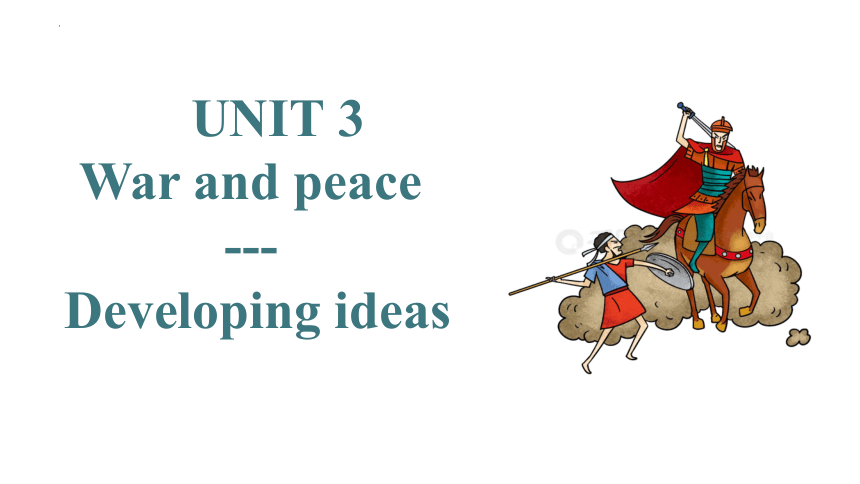 | |
| 格式 | zip | ||
| 文件大小 | 6.7MB | ||
| 资源类型 | 教案 | ||
| 版本资源 | 外研版(2019) | ||
| 科目 | 英语 | ||
| 更新时间 | 2023-05-08 20:51:32 | ||
图片预览

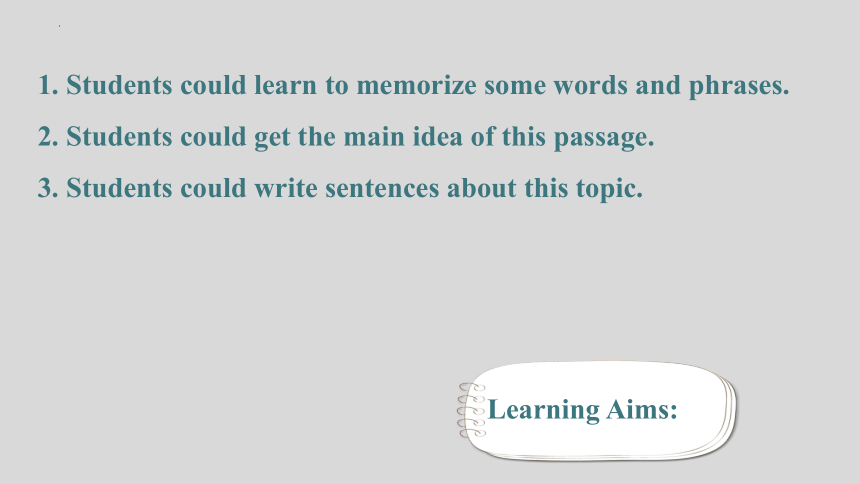
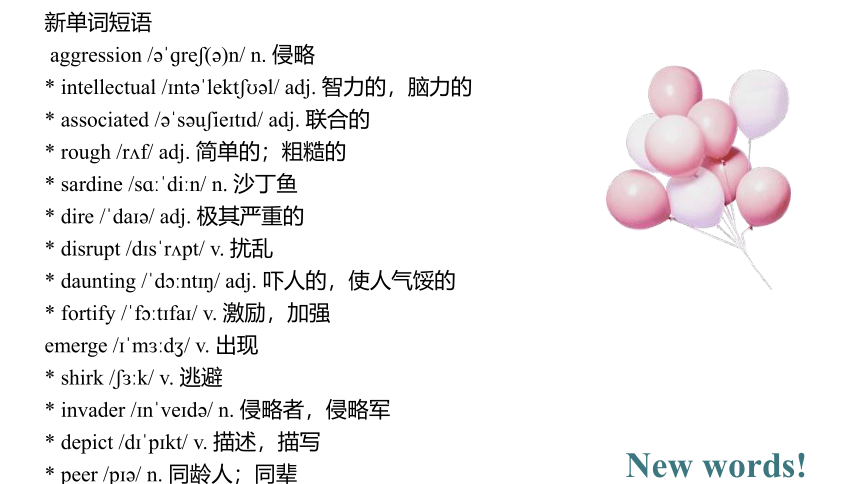
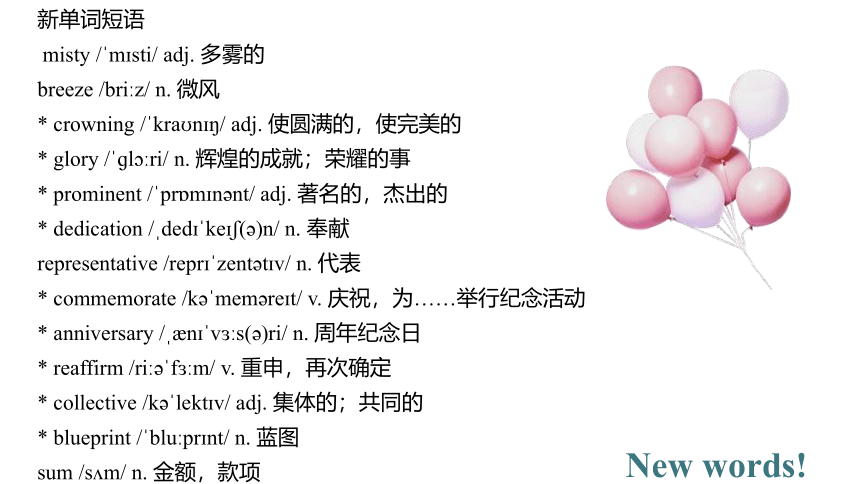
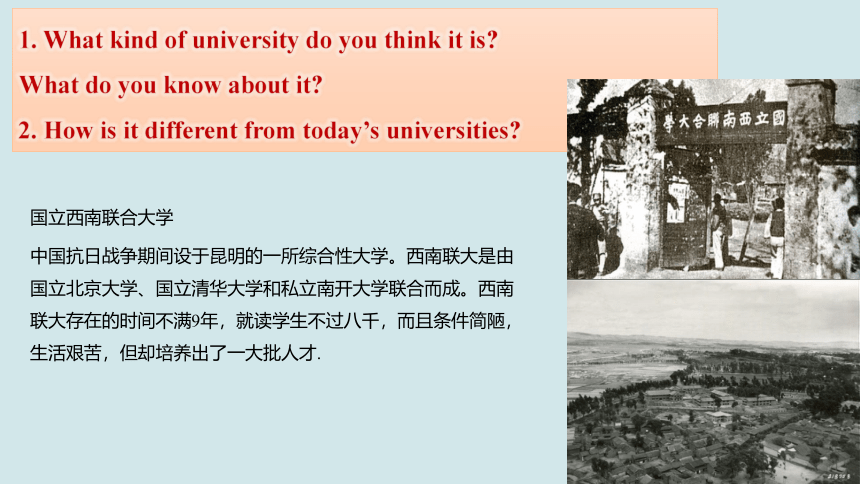
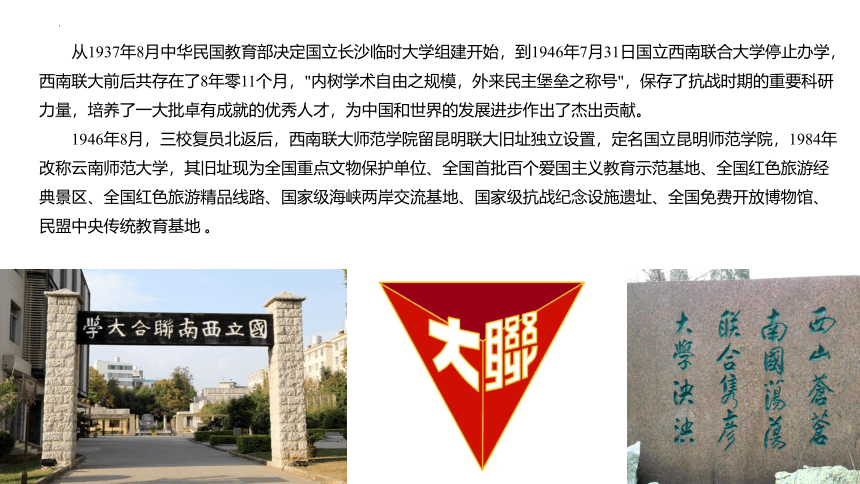

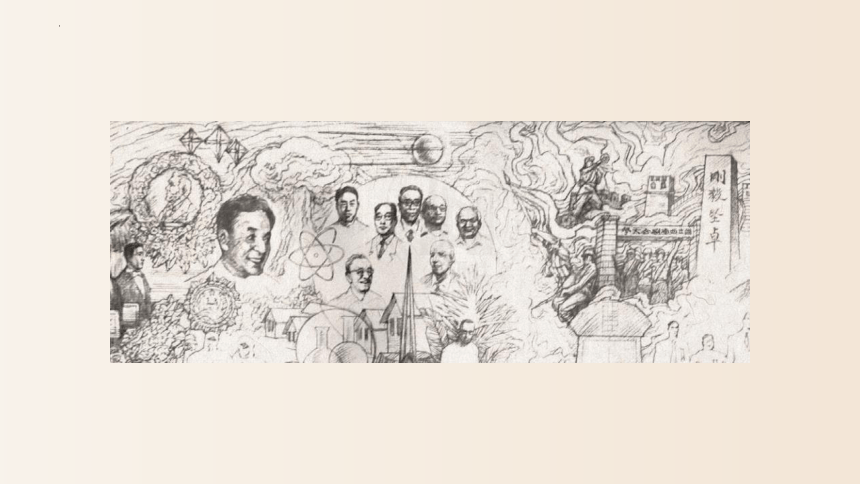
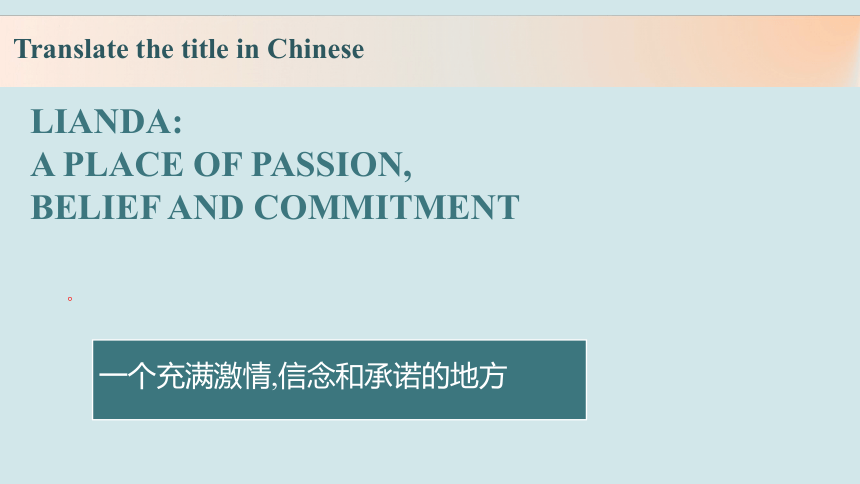

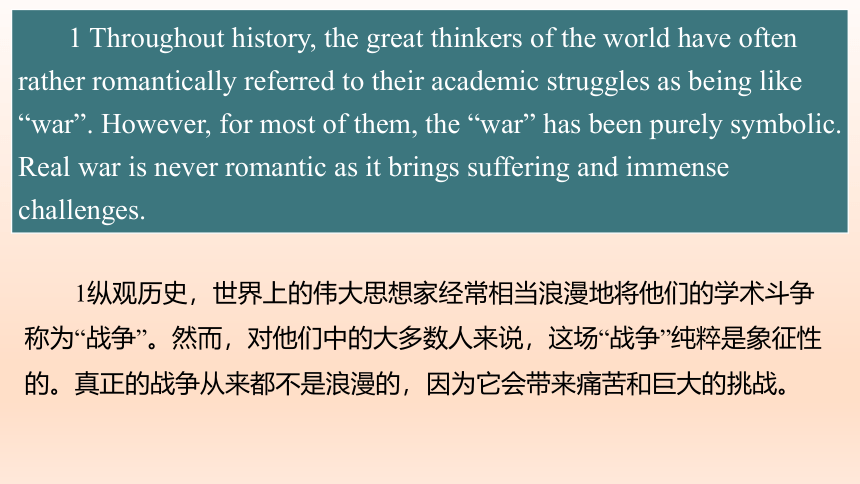
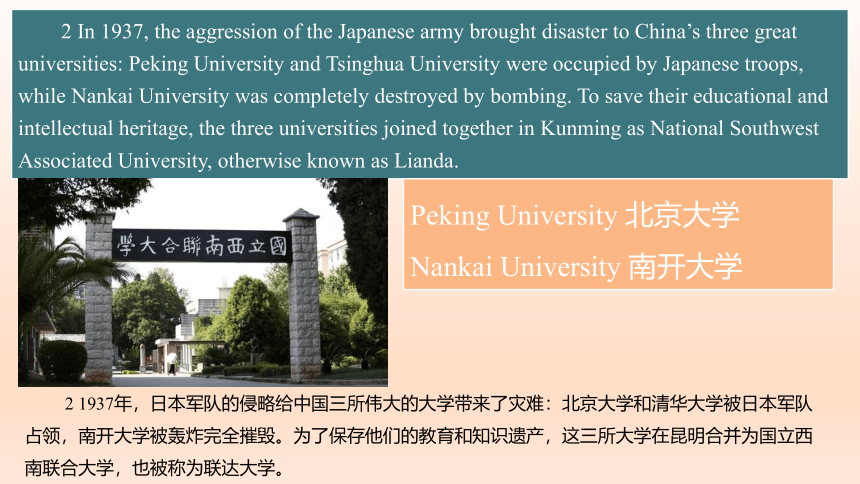
文档简介
(共31张PPT)
UNIT 3
War and peace
---
Developing ideas
1. Students could learn to memorize some words and phrases.
2. Students could get the main idea of this passage.
3. Students could write sentences about this topic.
Learning Aims:
新单词短语
aggression / ɡre ( )n/ n. 侵略
* intellectual / nt lekt l/ adj. 智力的,脑力的
* associated / s u ie t d/ adj. 联合的
* rough /r f/ adj. 简单的;粗糙的
* sardine /sɑ di n/ n. 沙丁鱼
* dire / da / adj. 极其严重的
* disrupt /d s r pt/ v. 扰乱
* daunting / d nt / adj. 吓人的,使人气馁的
* fortify / f t fa / v. 激励,加强
emerge / m d / v. 出现
* shirk / k/ v. 逃避
* invader / n ve d / n. 侵略者,侵略军
* depict /d p kt/ v. 描述,描写
* peer /p / n. 同龄人;同辈
New words!
新单词短语
misty / m sti/ adj. 多雾的
breeze /bri z/ n. 微风
* crowning / kra n / adj. 使圆满的,使完美的
* glory / ɡl ri/ n. 辉煌的成就;荣耀的事
* prominent / pr m n nt/ adj. 著名的,杰出的
* dedication / ded ke ( )n/ n. 奉献
representative /repr zent t v/ n. 代表
* commemorate /k mem re t/ v. 庆祝,为……举行纪念活动
* anniversary / n v s( )ri/ n. 周年纪念日
* reaffirm /ri f m/ v. 重申,再次确定
* collective /k lekt v/ adj. 集体的;共同的
* blueprint / blu pr nt/ n. 蓝图
sum /s m/ n. 金额,款项
New words!
1. What kind of university do you think it is
What do you know about it
2. How is it different from today’s universities
国立西南联合大学
中国抗日战争期间设于昆明的一所综合性大学。西南联大是由国立北京大学、国立清华大学和私立南开大学联合而成。西南联大存在的时间不满9年,就读学生不过八千,而且条件简陋,生活艰苦,但却培养出了一大批人才.
从1937年8月中华民国教育部决定国立长沙临时大学组建开始,到1946年7月31日国立西南联合大学停止办学,西南联大前后共存在了8年零11个月,"内树学术自由之规模,外来民主堡垒之称号",保存了抗战时期的重要科研力量,培养了一大批卓有成就的优秀人才,为中国和世界的发展进步作出了杰出贡献。
1946年8月,三校复员北返后,西南联大师范学院留昆明联大旧址独立设置,定名国立昆明师范学院,1984年改称云南师范大学,其旧址现为全国重点文物保护单位、全国首批百个爱国主义教育示范基地、全国红色旅游经典景区、全国红色旅游精品线路、国家级海峡两岸交流基地、国家级抗战纪念设施遗址、全国免费开放博物馆、民盟中央传统教育基地 。
Please try to make a prediction of this passage.
Translate the title in Chinese
。
一个充满激情,信念和承诺的地方
LIANDA:
A PLACE OF PASSION,
BELIEF AND COMMITMENT
Now read and check your prediction.
1 Throughout history, the great thinkers of the world have often rather romantically referred to their academic struggles as being like “war”. However, for most of them, the “war” has been purely symbolic. Real war is never romantic as it brings suffering and immense challenges.
1纵观历史,世界上的伟大思想家经常相当浪漫地将他们的学术斗争称为“战争”。然而,对他们中的大多数人来说,这场“战争”纯粹是象征性的。真正的战争从来都不是浪漫的,因为它会带来痛苦和巨大的挑战。
2 In 1937, the aggression of the Japanese army brought disaster to China’s three great universities: Peking University and Tsinghua University were occupied by Japanese troops, while Nankai University was completely destroyed by bombing. To save their educational and intellectual heritage, the three universities joined together in Kunming as National Southwest Associated University, otherwise known as Lianda.
2 1937年,日本军队的侵略给中国三所伟大的大学带来了灾难:北京大学和清华大学被日本军队占领,南开大学被轰炸完全摧毁。为了保存他们的教育和知识遗产,这三所大学在昆明合并为国立西南联合大学,也被称为联达大学。
Peking University 北京大学
Nankai University 南开大学
3 Professors and students alike in the three universities made an epic journey over a distance of more than 2,000 kilometres, most of them on foot. Their bed was the dusty road and their roof was the open sky, often lit up by exploding Japanese bombs. Conditions were little better once they reached the remote and mountainous south-west part of China. They had to live in rough buildings, packed 40 to a room, like sardines. There were dire shortages of food, books, and equipment. Furthermore, classes were frequently disrupted due to fierce air attacks and often had to be held before 10 am and after 4 pm.
3这三所大学的教授和学生都进行了一次2000多公里的史诗之旅,其中大多数是步行。他们的床是尘土飞扬的道路,屋顶是开阔的天空,经常被爆炸的日本炸弹照亮。他们到达中国西南部偏远多山的地区后,情况并没有好转。他们不得不住在粗糙的建筑里,一个房间挤了40个人,就像沙丁鱼一样。食物、书籍和设备严重短缺。此外,由于猛烈的空袭,上课经常中断,通常不得不在上午10点之前和下午4点之后进行。
due to 由于 ; 由于
lit up 点灯 ; 照亮
How is it different from today’s universities
It was made up of three established universities — that’s how it got its name.
4 However, despite the immense hardships and the daunting challenges, it was right in this place, over a period of eight long years, that the nation’s intellectual heritage was not only guarded but fortified by the passion and belief of the worthy academics of Lianda. It is no wonder that many, if not most, of China’s leading scholars and scientists emerged at Lianda, including the two Nobel Prize-winning physicists, Yang Zhenning and Li Zhengdao. “Lianda laid the foundation for every achievement I have made,” Yang recalled. He still remembers learning in a temporary classroom that had no glass in the windows. “On windy days, we had to hold down the paper on the desk, which would otherwise be blown away,” he said.
4然而,尽管面临着巨大的困难和艰巨的挑战,正是在这个地方,在长达八年的时间里,这个国家的知识遗产不仅得到了联达优秀学者的热情和信念的保护,而且得到了加强。难怪许多(如果不是大多数的话)中国顶尖学者和科学家出现在联达,包括两位诺贝尔物理学奖获得者杨振宁和李政道。“联达为我取得的每一项成就奠定了基础,”杨回忆道。他仍然记得在一间窗户上没有玻璃的临时教室里学习。“在刮风的日子里,我们不得不把桌子上的纸按住,否则会被吹走,”他说。
5 With the country at war, students at Lianda were not going to shirk their duty. Driven by a sense of commitment, a great many joined the army to resist the Japanese invaders and defend the honour of the nation. In fact, Lianda provided the largest number of student-soldiers from any campus in China. Of the thousands of college students from all over China who served as interpreters,one tenth were from Lianda, including the well-known translators Zha Liangzheng and Xu Yuanchong. Zha later depicted the contributions of his peers in a poem: Softly, on the hillside forgotten by all,A misty rain falls in a gentle breeze;There is no trace of the footprints of history;Where brave souls once stood, breathing new life into the trees.
5在国家处于战争状态的情况下,联达大学的学生不会逃避他们的责任。在承诺感的驱使下,许多人参军抵抗日本侵略者,捍卫国家荣誉。事实上,联达提供的学生士兵数量是中国所有校园中最多的。数千名来自中国各地的大学生担任翻译,其中十分之一来自联达,其中包括著名的翻译家查良政和许渊冲。查后来在一首诗中描述了他的同龄人的贡献:温柔地,在被所有人遗忘的山坡上,薄雾在微风中飘落;没有历史的足迹;勇敢的灵魂曾经站在那里,为树木注入新的生命。
6 A product of the war, Lianda is now physically gone. But it has become the crowning glory of China’s modern universities, not only because of its prominent professors and talented students, but also because of the school’s strong spirit of perseverance and dedication. In 2017, representatives from Peking University, Tsinghua University, Nankai University and Yunnan Normal University gathered to commemorate the 80th anniversary of its founding.
6作为战争的产物,连达现在已经离开了。但它已成为中国现代大学的最高荣耀,这不仅是因为它的杰出教授和才华横溢的学生,还因为学校强烈的毅力和奉献精神。2017年,来自北京大学、清华大学、南开大学和云南师范大学的代表齐聚一堂,纪念建校80周年。
7 More than eighty years on, the priceless contribution of Lianda still needs to be reaffirmed. It has become part of the collective memory of the Chinese nation, with its spirit as the blueprint for all universities in China in the modern era.
7八十多年过去了,联达的宝贵贡献仍需重申。它已经成为中华民族集体记忆的一部分,它的精神是现代中国所有大学的蓝图。
重点词汇
crowning glory 至高无上的荣耀 ; 至高无上的光荣
because of 因为 ; 因为,由于
due to 由于 ; 由于
lit up 点灯 ; 照亮
perseverance 毅力 ; 韧性 ; 不屈不挠的精神
Peking University 北京大学
Tsinghua University 清华大学 ;
Nankai University 南开大学 ;
commemorate 纪念 ; 作为…的纪念
for all 虽然;尽管
at war 在战争中
Choose the ideas that are included in the article.
1. Lianda was the best university in Chinese history.
2. The story of Lianda shows Chinese intellectuals’ academic pursuit and patriotism.
3. Only under difficult circumstances can students succeed.
4. Lianda has nurtured many outstanding scholars.
5. Lianda was a great success only because it had prominent professors and talented students.
6. People today still admire the spirit of Lianda.
2, 4, 6
重点词汇
intellectuals 知识分子
nurture养育
professors 教授
talented 天才的
admire 钦佩 ;
Try to find the part of speech of these sentences!
1. Their bed was the dusty road and their roof was the open sky, …
2. They had to live in rough buildings, packed 40 to a room, like sardines.
metaphor
simile
Learning to learn
Similes and metaphors are two commonly used, but easy to confuse, figures of speech. Similes compare and show similarities in typically different things. Similes usually use connecting words such as like, as, so and resemble. For example, He is as cool as a cucumber. Unlike similes, metaphors make direct comparisons without using connecting words. For example, She has a heart of a lion.
校园文化
校庆:1937年11月1日,国立长沙临时大学正式上课。这一天被定为国立西南联合大学的校庆日。
校训:刚毅坚卓
校歌:1939年,西南联大常委会核定《满江红》(冯友兰作词,张清常作曲)为联大校歌。歌词中的"仇寇"二字原为"倭虏"。
校风:民主自由、严谨求实、活泼创新、团结实干。
校徽:三角形的三等分,那一点是正三角形的三点合一,也暗含三角形的稳定性,上半年即已确定使用。
Writing about a war hero
重点词汇
Henan Province 河南省 ; 河南 ; 河北省 ; 省份河南省
Communist Party of China 中国共产党
United Army 联军
guerrilla war 游击战争 ; 游击战 ; 古巴战士
lack of supplies 供应不足 ; 货源缺乏
break through 冲破,突破 ; 冲破 ; 取得突破
large unit 大型机组
Answer the questions.
1 Who was Yang Jingyu
2 Why did Yang decide to let small groups of his men break through the encirclement
3 What did the Japanese find when they killed Yang
He was an anti-Japanese hero but died in a fight.
Because there was a critical lack of supplies.
tree bark, cotton and grass roots.
Now write an introduction to the war hero you chose.
How fierce the war was
Cruel, cold, violent, bloody
Try to talk your ideas with others
1.
2.
3.
Thank you!
UNIT 3
War and peace
---
Developing ideas
1. Students could learn to memorize some words and phrases.
2. Students could get the main idea of this passage.
3. Students could write sentences about this topic.
Learning Aims:
新单词短语
aggression / ɡre ( )n/ n. 侵略
* intellectual / nt lekt l/ adj. 智力的,脑力的
* associated / s u ie t d/ adj. 联合的
* rough /r f/ adj. 简单的;粗糙的
* sardine /sɑ di n/ n. 沙丁鱼
* dire / da / adj. 极其严重的
* disrupt /d s r pt/ v. 扰乱
* daunting / d nt / adj. 吓人的,使人气馁的
* fortify / f t fa / v. 激励,加强
emerge / m d / v. 出现
* shirk / k/ v. 逃避
* invader / n ve d / n. 侵略者,侵略军
* depict /d p kt/ v. 描述,描写
* peer /p / n. 同龄人;同辈
New words!
新单词短语
misty / m sti/ adj. 多雾的
breeze /bri z/ n. 微风
* crowning / kra n / adj. 使圆满的,使完美的
* glory / ɡl ri/ n. 辉煌的成就;荣耀的事
* prominent / pr m n nt/ adj. 著名的,杰出的
* dedication / ded ke ( )n/ n. 奉献
representative /repr zent t v/ n. 代表
* commemorate /k mem re t/ v. 庆祝,为……举行纪念活动
* anniversary / n v s( )ri/ n. 周年纪念日
* reaffirm /ri f m/ v. 重申,再次确定
* collective /k lekt v/ adj. 集体的;共同的
* blueprint / blu pr nt/ n. 蓝图
sum /s m/ n. 金额,款项
New words!
1. What kind of university do you think it is
What do you know about it
2. How is it different from today’s universities
国立西南联合大学
中国抗日战争期间设于昆明的一所综合性大学。西南联大是由国立北京大学、国立清华大学和私立南开大学联合而成。西南联大存在的时间不满9年,就读学生不过八千,而且条件简陋,生活艰苦,但却培养出了一大批人才.
从1937年8月中华民国教育部决定国立长沙临时大学组建开始,到1946年7月31日国立西南联合大学停止办学,西南联大前后共存在了8年零11个月,"内树学术自由之规模,外来民主堡垒之称号",保存了抗战时期的重要科研力量,培养了一大批卓有成就的优秀人才,为中国和世界的发展进步作出了杰出贡献。
1946年8月,三校复员北返后,西南联大师范学院留昆明联大旧址独立设置,定名国立昆明师范学院,1984年改称云南师范大学,其旧址现为全国重点文物保护单位、全国首批百个爱国主义教育示范基地、全国红色旅游经典景区、全国红色旅游精品线路、国家级海峡两岸交流基地、国家级抗战纪念设施遗址、全国免费开放博物馆、民盟中央传统教育基地 。
Please try to make a prediction of this passage.
Translate the title in Chinese
。
一个充满激情,信念和承诺的地方
LIANDA:
A PLACE OF PASSION,
BELIEF AND COMMITMENT
Now read and check your prediction.
1 Throughout history, the great thinkers of the world have often rather romantically referred to their academic struggles as being like “war”. However, for most of them, the “war” has been purely symbolic. Real war is never romantic as it brings suffering and immense challenges.
1纵观历史,世界上的伟大思想家经常相当浪漫地将他们的学术斗争称为“战争”。然而,对他们中的大多数人来说,这场“战争”纯粹是象征性的。真正的战争从来都不是浪漫的,因为它会带来痛苦和巨大的挑战。
2 In 1937, the aggression of the Japanese army brought disaster to China’s three great universities: Peking University and Tsinghua University were occupied by Japanese troops, while Nankai University was completely destroyed by bombing. To save their educational and intellectual heritage, the three universities joined together in Kunming as National Southwest Associated University, otherwise known as Lianda.
2 1937年,日本军队的侵略给中国三所伟大的大学带来了灾难:北京大学和清华大学被日本军队占领,南开大学被轰炸完全摧毁。为了保存他们的教育和知识遗产,这三所大学在昆明合并为国立西南联合大学,也被称为联达大学。
Peking University 北京大学
Nankai University 南开大学
3 Professors and students alike in the three universities made an epic journey over a distance of more than 2,000 kilometres, most of them on foot. Their bed was the dusty road and their roof was the open sky, often lit up by exploding Japanese bombs. Conditions were little better once they reached the remote and mountainous south-west part of China. They had to live in rough buildings, packed 40 to a room, like sardines. There were dire shortages of food, books, and equipment. Furthermore, classes were frequently disrupted due to fierce air attacks and often had to be held before 10 am and after 4 pm.
3这三所大学的教授和学生都进行了一次2000多公里的史诗之旅,其中大多数是步行。他们的床是尘土飞扬的道路,屋顶是开阔的天空,经常被爆炸的日本炸弹照亮。他们到达中国西南部偏远多山的地区后,情况并没有好转。他们不得不住在粗糙的建筑里,一个房间挤了40个人,就像沙丁鱼一样。食物、书籍和设备严重短缺。此外,由于猛烈的空袭,上课经常中断,通常不得不在上午10点之前和下午4点之后进行。
due to 由于 ; 由于
lit up 点灯 ; 照亮
How is it different from today’s universities
It was made up of three established universities — that’s how it got its name.
4 However, despite the immense hardships and the daunting challenges, it was right in this place, over a period of eight long years, that the nation’s intellectual heritage was not only guarded but fortified by the passion and belief of the worthy academics of Lianda. It is no wonder that many, if not most, of China’s leading scholars and scientists emerged at Lianda, including the two Nobel Prize-winning physicists, Yang Zhenning and Li Zhengdao. “Lianda laid the foundation for every achievement I have made,” Yang recalled. He still remembers learning in a temporary classroom that had no glass in the windows. “On windy days, we had to hold down the paper on the desk, which would otherwise be blown away,” he said.
4然而,尽管面临着巨大的困难和艰巨的挑战,正是在这个地方,在长达八年的时间里,这个国家的知识遗产不仅得到了联达优秀学者的热情和信念的保护,而且得到了加强。难怪许多(如果不是大多数的话)中国顶尖学者和科学家出现在联达,包括两位诺贝尔物理学奖获得者杨振宁和李政道。“联达为我取得的每一项成就奠定了基础,”杨回忆道。他仍然记得在一间窗户上没有玻璃的临时教室里学习。“在刮风的日子里,我们不得不把桌子上的纸按住,否则会被吹走,”他说。
5 With the country at war, students at Lianda were not going to shirk their duty. Driven by a sense of commitment, a great many joined the army to resist the Japanese invaders and defend the honour of the nation. In fact, Lianda provided the largest number of student-soldiers from any campus in China. Of the thousands of college students from all over China who served as interpreters,one tenth were from Lianda, including the well-known translators Zha Liangzheng and Xu Yuanchong. Zha later depicted the contributions of his peers in a poem: Softly, on the hillside forgotten by all,A misty rain falls in a gentle breeze;There is no trace of the footprints of history;Where brave souls once stood, breathing new life into the trees.
5在国家处于战争状态的情况下,联达大学的学生不会逃避他们的责任。在承诺感的驱使下,许多人参军抵抗日本侵略者,捍卫国家荣誉。事实上,联达提供的学生士兵数量是中国所有校园中最多的。数千名来自中国各地的大学生担任翻译,其中十分之一来自联达,其中包括著名的翻译家查良政和许渊冲。查后来在一首诗中描述了他的同龄人的贡献:温柔地,在被所有人遗忘的山坡上,薄雾在微风中飘落;没有历史的足迹;勇敢的灵魂曾经站在那里,为树木注入新的生命。
6 A product of the war, Lianda is now physically gone. But it has become the crowning glory of China’s modern universities, not only because of its prominent professors and talented students, but also because of the school’s strong spirit of perseverance and dedication. In 2017, representatives from Peking University, Tsinghua University, Nankai University and Yunnan Normal University gathered to commemorate the 80th anniversary of its founding.
6作为战争的产物,连达现在已经离开了。但它已成为中国现代大学的最高荣耀,这不仅是因为它的杰出教授和才华横溢的学生,还因为学校强烈的毅力和奉献精神。2017年,来自北京大学、清华大学、南开大学和云南师范大学的代表齐聚一堂,纪念建校80周年。
7 More than eighty years on, the priceless contribution of Lianda still needs to be reaffirmed. It has become part of the collective memory of the Chinese nation, with its spirit as the blueprint for all universities in China in the modern era.
7八十多年过去了,联达的宝贵贡献仍需重申。它已经成为中华民族集体记忆的一部分,它的精神是现代中国所有大学的蓝图。
重点词汇
crowning glory 至高无上的荣耀 ; 至高无上的光荣
because of 因为 ; 因为,由于
due to 由于 ; 由于
lit up 点灯 ; 照亮
perseverance 毅力 ; 韧性 ; 不屈不挠的精神
Peking University 北京大学
Tsinghua University 清华大学 ;
Nankai University 南开大学 ;
commemorate 纪念 ; 作为…的纪念
for all 虽然;尽管
at war 在战争中
Choose the ideas that are included in the article.
1. Lianda was the best university in Chinese history.
2. The story of Lianda shows Chinese intellectuals’ academic pursuit and patriotism.
3. Only under difficult circumstances can students succeed.
4. Lianda has nurtured many outstanding scholars.
5. Lianda was a great success only because it had prominent professors and talented students.
6. People today still admire the spirit of Lianda.
2, 4, 6
重点词汇
intellectuals 知识分子
nurture养育
professors 教授
talented 天才的
admire 钦佩 ;
Try to find the part of speech of these sentences!
1. Their bed was the dusty road and their roof was the open sky, …
2. They had to live in rough buildings, packed 40 to a room, like sardines.
metaphor
simile
Learning to learn
Similes and metaphors are two commonly used, but easy to confuse, figures of speech. Similes compare and show similarities in typically different things. Similes usually use connecting words such as like, as, so and resemble. For example, He is as cool as a cucumber. Unlike similes, metaphors make direct comparisons without using connecting words. For example, She has a heart of a lion.
校园文化
校庆:1937年11月1日,国立长沙临时大学正式上课。这一天被定为国立西南联合大学的校庆日。
校训:刚毅坚卓
校歌:1939年,西南联大常委会核定《满江红》(冯友兰作词,张清常作曲)为联大校歌。歌词中的"仇寇"二字原为"倭虏"。
校风:民主自由、严谨求实、活泼创新、团结实干。
校徽:三角形的三等分,那一点是正三角形的三点合一,也暗含三角形的稳定性,上半年即已确定使用。
Writing about a war hero
重点词汇
Henan Province 河南省 ; 河南 ; 河北省 ; 省份河南省
Communist Party of China 中国共产党
United Army 联军
guerrilla war 游击战争 ; 游击战 ; 古巴战士
lack of supplies 供应不足 ; 货源缺乏
break through 冲破,突破 ; 冲破 ; 取得突破
large unit 大型机组
Answer the questions.
1 Who was Yang Jingyu
2 Why did Yang decide to let small groups of his men break through the encirclement
3 What did the Japanese find when they killed Yang
He was an anti-Japanese hero but died in a fight.
Because there was a critical lack of supplies.
tree bark, cotton and grass roots.
Now write an introduction to the war hero you chose.
How fierce the war was
Cruel, cold, violent, bloody
Try to talk your ideas with others
1.
2.
3.
Thank you!
